Sustainable Printing 4.0—Insights from a Polish Survey
Abstract
:1. Introduction
- How can applications of I4.0 support sustainability goals?
- How can I4.0 technologies, tools, and solutions be integrated with the implementation of sustainability practices on a theoretical and practical basis?
- status of Industry 4.0 implementation in a company;
- status of implementation of sustainability practices in a company;
- dependences between Industry4.0 and sustainability practices in the printing sector.
- The following detailed questions were considered:
- What is the awareness level concerning the Industry 4.0 technologies and sustainability practices in your company?
- Which Industry 4.0 technologies are currently used in your company or which do you plan to implement in the future?
- Which sustainability practices are currently used in your company or do you plan to implement in the future?
- In which areas of your company‘s business activities do you use Industry 4.0 technologies and sustainability practices?
- Which obstacles did you encounter when implementing/using Industry 4.0 technologies and sustainability practices in your company?
- Do Industry 4.0 technologies and sustainability practices currently contribute to your company or will they in the future?
2. Materials and Methods
3. Results
3.1. What Is the Awareness Level Concerning the Industry 4.0 Technologies and Sustainability Practices in Your Company?
3.2. Which Industry 4.0 Technologies Are Currently Used in Your Company or Which Do You Plan to Implement in the Future?
3.3. Which Sustainability Practices Are Currently Used in Your Company or Do You Plan to Implement in the Future?
3.4. In Which Areas of Your Company’s Business Activities Do You Use Industry 4.0 Technologies and Sustainability Practices?
Using IoT inside the company, data from sensors, machines, and devices are collected and processed.
We follow Circular Economy trends and try to meet legal requirements, keeping up with the current trends.
Referring to the protection of the environment, it is worth mentioning the new, modern building of the company, equipped with advanced recuperation technologies, air purification, energy and water saving systems... etc. […] After introducing innovative solutions and technologies in the newly built investment, based on the indications of the installed equipment, the company achieved significant savings. The period of 3 months of operation in the new premises was taken into account and compared with the corresponding period of operation in the previous location. Approximate results are presented:
3.5. Which Obstacles Did You Encounter When Implementing/Using Industry 4.0 Technologies and Sustainability Practices in Your Company?
3.6. Do Industry 4.0 Technologies and Sustainability Practices Currently Contribute to Your Company or Will They in the Future?
I4.0 should enable the balance and optimization of the supply chain, lead to less waste of energy, labor, and material; I4.0 could also contribute to the optimization of stock levels, as currently many products are wasted due to the expiry date.
I4 and SD are strongly related. I4 delivers instruments to achieve sustainable development goals (SDG). Decisions on I4 implementation are strongly related to achievement of SDG. Electro waste is risky, unemployment is risky. New technologies’ decisions have to consider SDG.
Recyclable products, re-manufactured with 100% rPET, loss management, to reduce material losses.
Industry 4.0 forces a modification of the traditional perception of production. The ongoing transformation is inextricably linked with digital information technologies. This is an opportunity for the environment. Modern technologies offer many benefits by increasing the use of renewable energy in production, reducing CO2 emissions, increasing energy efficiency in industry, or increasing the productivity of enterprises. The Industry 4.0 concept is based on eco-innovation, including eco-efficiency and cleaner (green) production. It is closely related to the idea of sustainability. Technological solutions of Industry 4.0, created thanks to individual and collective knowledge resources, can provide many highly functional products and services to their users and suppliers with much lower negative impact on the environment and society in a turbulent environment. A company operating in line with Industry 4.0 and adhering to the principles of sustainability can thrive in times of less and less predictable events and quickly adapt to the changing conditions in its environment.
4. Discussion
4.1. Impacts of Industry 4.0 on the Printing Industry
4.2. Awareness of Sustainability and Achieving It through Industry 4.0 in the Printing Industry in Poland
- The concepts of SDG and sustainability are much older and more mature than Industry 4.0;
- For printing companies and their customers, the importance of achieving SDG and sustainability goals is more important and less costly than applying Industry 4.0;
- National and EU legal regulations already require the implementation of certain activities related to SDG;
- It is much easier to implement some SDG- or TBL-related recommendations or guidelines than to implement Industry 4.0 technologies.
4.3. Challenges to the Adoption of Industry 4.0 and Achieving Sustainability
5. Implication for Research
5.1. Theoretical Implications
- H1: Company size determines the scope of I4.0 implementation in the printing company.
- H2: Company size determines the scope of sustainability-oriented actions of the printing company.
- H3: The scope of I4.0 implementation determines the scope of sustainability-oriented actions in the printing company.
- H4: The better the alignment of the I4.0 concept with the company’s strategic objectives is, the better the alignment of the sustainability concept with company‘s strategic objectives is, both currently and in the future in the printing company.
5.2. Managerial Implications
- proposing the diagnosis questionnaire facilitating research on the I4.0—SD relationship;
- providing the inclusion of qualitative analyses of obtained results;
- providing the validation of the questionnaire, and the attempt to indicate the future direction of business in terms of the integration of I4.0 technologies and SD objectives for the printing industry;
- sharing knowledge on the Industry 4.0—SD relationship in printing for other industries. This has been possible due to the literature review giving opportunities to distinguish the most important categories of questions for which answers are sought in the literature.
6. Conclusions
6.1. Diagnosis of Sustainable Industry 4.0 in the Printing Industry in Poland
6.2. Directions of Further Research Agenda
Author Contributions
Funding
Institutional Review Board Statement
Informed Consent Statement
Data Availability Statement
Acknowledgments
Conflicts of Interest
Appendix A
| Company | Size | Range of Operations | Interviewee’s Position |
|---|---|---|---|
| A | Medium | European | R&D Manager |
| B | Large | Global | Chief Executive Officer |
| C | Medium | European | Chief Technology Officer |
| D | Large | European | R&D Engineer |
| E | Medium | European | Technology Manager |
| F | Medium | International | Lean Manager |
| G | Large | International | Chief Operation Officer |
| H | Medium | European | Chief Executive Officer |
| I | Small | European | Vice Chief Executive Officer |
| J | Small | National | Deputy Production Manager |
| K | Large | European | Prepress Manager |
References
- Baykina, R.N.; Lisovsky, A.L.; Yussuf, A.A. Assessment of a Sustainable Development Potential of Printing Companies in the Digital Economy Environment. In Proceedings of the Inclusive Development of Society: Proceedings of the 6th International Conference on Management and Technology in Knowledge, Service, Tourism & Hospitality (SERVE 2018); CRC Press: Boca Raton, FL, USA, 2020; p. 22. [Google Scholar]
- Moreira, A.; Silva, F.J.G.; Correia, A.I.; Pereira, T.; Ferreira, L.P.; de Almeida, F. Cost Reduction and Quality Improvements in the Printing Industry. Procedia Manuf. 2018, 17, 623–630. [Google Scholar] [CrossRef]
- Kiurski, J.; Marić, B.; Adamović, D.; Mihailović, A.; Grujić, S.; Oros, I.; Krstić, J. Register of Hazardous Materials in Printing Industry as a Tool for Sustainable Development Management. Renew. Sustain. Energy Rev. 2012, 16, 660–667. [Google Scholar] [CrossRef]
- Kiurski, J.S.; Marić, B.B.; Oros, I.B.; Kecić, V.S. The Ecodesign Practice in Serbian Printing Industry. J. Clean. Prod. 2017, 149, 1200–1209. [Google Scholar] [CrossRef]
- Tischner, U.; Nickel, R. Eco-Design in the Printing Industry Life Cycle Thinking: Implementation of Eco-Design Concepts and Tools into the Routine Procedures of Companies. J. Sustain. Prod. Des. 2003, 3, 19–27. [Google Scholar] [CrossRef]
- Pai, A.S.; Rodrigues, L.L.R. Green Printing: A Sustainable and Environmental Friendly Approach for Printers. In Proceedings of the International Conference on Environment and Sustainable Technologies, Manipal Institute of Technology, Manipal, India, 4 January 2014. [Google Scholar]
- Cristóbal Andrade, L.; Gómez Míguez, C.; Taboada Gómez, M.C.; Bello Bugallo, P.M. Management Strategy for Hazardous Waste from Atomised SME: Application to the Printing Industry. J. Clean. Prod. 2012, 35, 214–229. [Google Scholar] [CrossRef]
- Lipiak, J.; Salwin, M. The Improvement of Sustainability with Reference to the Printing Industry—Case Study. In Advances in Manufacturing II; Hamrol, A., Grabowska, M., Maletic, D., Woll, R., Eds.; Springer International Publishing: Cham, Switzerland, 2019; pp. 254–266. [Google Scholar]
- Kayode, F.; Ogunlade, B. Environmental Management in the Printing Industry. J. Sociol. Res. 2012, 3, 181–188. [Google Scholar] [CrossRef] [Green Version]
- Hayta, P.; Oktav, M. The Importance of Waste and Environment Management in Printing Industry. Eur. J. Eng. Nat. Sci. 2019, 3, 18–26. [Google Scholar]
- World Commission on Environment and Development. Our Common Future; United Nations (UN): New York, NY, USA, 1987; ISBN 978-0-19-282080-8. [Google Scholar]
- Kinderyte, L. Sustainability Assessment of Enterprises in Printing Industry. EREM 2011, 58, 59–64. [Google Scholar] [CrossRef]
- Kai, D.A.; de Lima, E.P.; da Costa, S.E.G. Developing a Conceptual Framework for Assessing Printing Companies Operations Sustainability Pratices; IFPR, ABEPRO: Iguassu Falls, Brazil, 2015; pp. 1–8. [Google Scholar]
- Kiurski, J.; Marić, B.; Djaković, V.; Adamović, S.; Oros, I.; Krstić, J. The Impact Factors of the Environmental Pollution and Workers Health in Printing Industry. Int. J. Humanit. Soc. Sci. 2012, 6, 69–72. [Google Scholar]
- Salwin, M.; Santarek, K.; Kraslawski, A.; Lipiak, J. Product-Service System: A New Opportunity for the Printing Industry. In Advanced Manufacturing Processes II; Tonkonogyi, V., Ivanov, V., Trojanowska, J., Oborskyi, G., Grabchenko, A., Pavlenko, I., Edl, M., Kuric, I., Dasic, P., Eds.; Springer International Publishing: Cham, Switzerland, 2021; pp. 83–95. [Google Scholar]
- Salwin, M.; Kraslawski, A.; Lipiak, J.; Gołębiewski, D.; Andrzejewski, M. Product-Service System Business Model for Printing Houses. J. Clean. Prod. 2020, 274, 122939. [Google Scholar] [CrossRef]
- Kagermann, H.; Lukas, W.-D.; Wahlster, W. Industrie 4.0: Mit Dem Internet Der Dinge Auf Dem Weg Zur 4. Industriellen Revolution. Vdi Nachr. 2011, 13, 2–3. [Google Scholar]
- Kagermann, H.; Anderl, R.; Gausemeier, J.; Schuh, G.; Wahlster, W. Industrie 4.0 in a Global Context: Strategies for Cooperating with International Partners; utzverlag GmbH: München, Germany, 2016; ISBN 978-3-8316-4504-6. [Google Scholar]
- Madsen, D. The Emergence and Rise of Industry 4.0 Viewed through the Lens of Management Fashion Theory. Adm. Sci. 2019, 9, 71. [Google Scholar] [CrossRef] [Green Version]
- Oesterreich, T.D.; Schuir, J.; Teuteberg, F. The Emperor’s New Clothes or an Enduring IT Fashion? Analyzing the Lifecycle of Industry 4.0 through the Lens of Management Fashion Theory. Sustainability 2020, 12, 8828. [Google Scholar] [CrossRef]
- Melville, N.P.; Robert, L. The Generative Fourth Industrial Revolution: Features, Affordances, and Implications. SSRN Electron. J. 2020, 1–20. [Google Scholar] [CrossRef]
- Bongomin, O.; Yemane, A.; Kembabazi, B.; Malanda, C.; Chikonkolo Mwape, M.; Sheron Mpofu, N.; Tigalana, D. Industry 4.0 Disruption and Its Neologisms in Major Industrial Sectors: A State of the Art. J. Eng. 2020, 2020, e8090521. [Google Scholar] [CrossRef]
- Xu, L.D.; Xu, E.L.; Li, L. Industry 4.0: State of the Art and Future Trends. Int. J. Prod. Res. 2018, 56, 2941–2962. [Google Scholar] [CrossRef] [Green Version]
- Calabrese, A.; Ghiron, N.L.; Tiburzi, L. ‘Evolutions’ and ‘Revolutions’ in Manufacturers’ Implementation of Industry 4.0: A Literature Review, a Multiple Case Study, and a Conceptual Framework. Prod. Plan. Control 2021, 32, 213–227. [Google Scholar] [CrossRef]
- Liao, Y.; Deschamps, F.; Loures, E.d.F.R.; Ramos, L.F.P. Past, Present and Future of Industry 4.0—A Systematic Literature Review and Research Agenda Proposal. Int. J. Prod. Res. 2017, 55, 3609–3629. [Google Scholar] [CrossRef]
- Oztemel, E.; Gursev, S. Literature Review of Industry 4.0 and Related Technologies. J. Intell. Manuf. 2020, 31, 127–182. [Google Scholar] [CrossRef]
- Bongomin, O.; Nganyi, E.O.; Abswaidi, M.R.; Hitiyise, E.; Tumusiime, G. Sustainable and Dynamic Competitiveness towards Technological Leadership of Industry 4.0: Implications for East African Community. J. Eng. 2020, 2020, e8545281. [Google Scholar] [CrossRef]
- Grenčíková, A.; Kordoš, M.; Sokol, J. The Approach to Industry 4.0 within the Slovak Business Environment. Soc. Sci. 2019, 8, 104. [Google Scholar] [CrossRef] [Green Version]
- Ejsmont, K.; Gladysz, B.; Kluczek, A. Impact of Industry 4.0 on Sustainability—Bibliometric Literature Review. Sustainability 2020, 12, 5650. [Google Scholar] [CrossRef]
- Kovacs, O. Big IFs in Productivity-Enhancing Industry 4.0. Soc. Sci. 2019, 8, 37. [Google Scholar] [CrossRef] [Green Version]
- Sony, M. Pros and Cons of Implementing Industry 4.0 for the Organizations: A Review and Synthesis of Evidence. Prod. Manuf. Res. 2020, 8, 244–272. [Google Scholar] [CrossRef]
- Sony, M.; Naik, S.S. Ten Lessons for Managers While Implementing Industry 4.0. IEEE Eng. Manag. Rev. 2019, 47, 45–52. [Google Scholar] [CrossRef]
- Sony, M.; Naik, S. Critical Factors for the Successful Implementation of Industry 4.0: A Review and Future Research Direction. Prod. Plan. Control. 2020, 31, 799–815. [Google Scholar] [CrossRef]
- Pereira, G.B.; Santos, A.d.P.L.; Cleto, M.G. INDUSTRY 4.0: Glitter or Gold? A Systematic Review. Braz. J. Oper. Prod. Manag. 2018, 15, 247–253. [Google Scholar] [CrossRef] [Green Version]
- Brozzi, R.; Forti, D.; Rauch, E.; Matt, D.T. The Advantages of Industry 4.0 Applications for Sustainability: Results from a Sample of Manufacturing Companies. Sustainability 2020, 12, 3647. [Google Scholar] [CrossRef]
- Cioffi, R.; Travaglioni, M.; Piscitelli, G.; Petrillo, A.; Parmentola, A. Smart Manufacturing Systems and Applied Industrial Technologies for a Sustainable Industry: A Systematic Literature Review. Appl. Sci. 2020, 10, 2897. [Google Scholar] [CrossRef] [Green Version]
- Adamik, A. SMEs on the Way to the Smart World of Industry 4.0. In Eurasian Business Perspectives; Bilgin, M.H., Danis, H., Demir, E., Ucal, M.Ş., Eds.; Springer International Publishing: Cham, Switzerland, 2020; pp. 139–156. [Google Scholar]
- Adamik, A.; Nowicki, M. Preparedness of Companies for Digital Transformation and Creating a Competitive Advantage in the Age of Industry 4.0. Proc. Int. Conf. Bus. Excell. 2018, 12, 10–24. [Google Scholar] [CrossRef] [Green Version]
- Basl, J. Pilot Study of Readiness of Czech Companies to Implement the Principles of Industry 4.0. Manag. Prod. Eng. Rev. 2017, 8, 3–8. [Google Scholar] [CrossRef] [Green Version]
- Kamble, S.S.; Gunasekaran, A.; Sharma, R. Analysis of the Driving and Dependence Power of Barriers to Adopt Industry 4.0 in Indian Manufacturing Industry. Comput. Ind. 2018, 101, 107–119. [Google Scholar] [CrossRef]
- Lee, S.M.; Trimi, S. Innovation for Creating a Smart Future. J. Innov. Knowl. 2018, 3, 1–8. [Google Scholar] [CrossRef]
- Bongomin, O.; Ocen, G.G.; Nganyi, O.E.; Musinguzi, A.; Omara, T. Exponential Disruptive Technologies and the Required Skills of Industry 4.0. J. Eng. 2020, 2020, e4280156. [Google Scholar] [CrossRef] [Green Version]
- Vrchota, J.; Volek, T.; Novotná, M. Factors Introducing Industry 4.0 to SMES. Soc. Sci. 2019, 8, 130. [Google Scholar] [CrossRef] [Green Version]
- Tavares-Lehmann, A.T.; Varum, C. Industry 4.0 and Sustainability: A Bibliometric Literature Review. Sustainability 2021, 13, 3493. [Google Scholar] [CrossRef]
- Villalba-Diez, J.; Schmidt, D.; Gevers, R.; Ordieres-Meré, J.; Buchwitz, M.; Wellbrock, W. Deep Learning for Industrial Computer Vision Quality Control in the Printing Industry 4.0. Sensors 2019, 19, 3987. [Google Scholar] [CrossRef] [Green Version]
- Che, A.M. Ensuring Environmental Sustainability in the Printing Industry. Master’s Thesis, Faculty of Natural Resources and Agricultural Sciences, Department of Economics, Uppsala, Sweden, December 2011. [Google Scholar]
- Statistics Poland. Statistical Yearbook of Industry—Poland; Statistics Poland: Warsaw, Poland, 2021.
- Canon Industry 4.0: The Smart Print Factory. Available online: https://pps.csa.canon.com/newsletter-article/book-printers-publishers/2018-12-01-000000/industry-40-smart-print-factory2018-12 (accessed on 29 June 2021).
- Baldwin Industry 4.0 for Printing, Packaging, Converting|Baldwin Technology Company. Available online: https://baldwintech.com/industrial-iot-for-printing-and-packaging (accessed on 29 June 2021).
- FESPA Industry 4.0 Is Starting to Happen. Available online: https://www.fespa.com/en/news-media/features/industry-4-0-is-starting-to-happen (accessed on 29 June 2021).
- Packaging Europe Print and Labelling: Focus on Industry 4.0—Packaging Europe. Available online: https://packagingeurope.com/print-and-labelling-focus-on-industry-4-0/ (accessed on 29 June 2021).
- Antonelli, C.; Scellato, G. Firms Size and Directed Technological Change. Small Bus. Econ. 2015, 44, 207–218. [Google Scholar] [CrossRef] [Green Version]
- Malaquias, R.F.; Hwang, Y. Firms’ Size and Use of Information and Communication Technologies: Empirical Evidence on Small Businesses in Brazil. Inf. Dev. 2016, 32, 1613–1620. [Google Scholar] [CrossRef]
- Kumar, S.; Raut, R.D.; Narwane, V.S.; Narkhede, B.E.; Muduli, K. Implementation Barriers of Smart Technology in Indian Sustainable Warehouse by Using a Delphi-ISM-ANP Approach. Int. J. Product. Perform. Manag. 2021. ahead of print. [Google Scholar] [CrossRef]
- Mazurkiewicz, A. Barriers of Technological Innovation Development and Implementation Encountered by R&D Organisations. J. Mach. Constr. Maint.—Probl. Eksploat. 2018, 1, 127–138. [Google Scholar]
- Veile, J.; Birkel, H.; Schmidt, M.-C.; Rücker, M.; Müller, J.; Hartmann, E.; Voigt, K.-I. Green and Lean?—Understanding Ecological and Environmental Implications in the Light of Industry 4.0. In Proceedings of the International Conference on Resource Sustainability, University College Dublin, Dublin, Ireland, 19–23 July 2021; 2021. [Google Scholar]
- Van Erp, T.; Obenaus, M.; Kunz, S.; Kohl, H. Industry 4.0 as Enabler for a Sustainable Development: A Qualitative Assessment of Its Ecological and Social Potential. Process. Saf. Environ. Prot. 2018, 118, 254–267. [Google Scholar] [CrossRef]
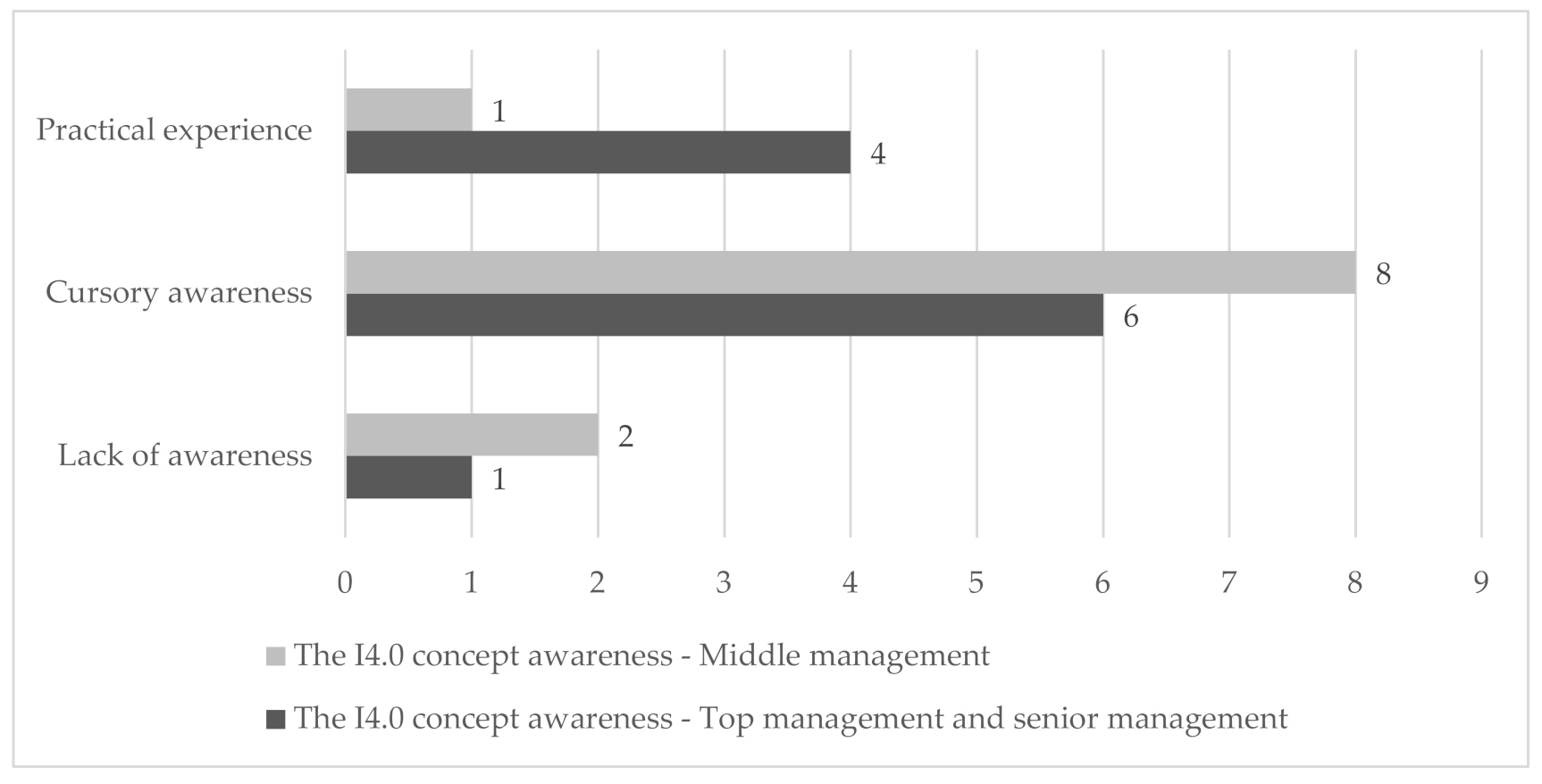
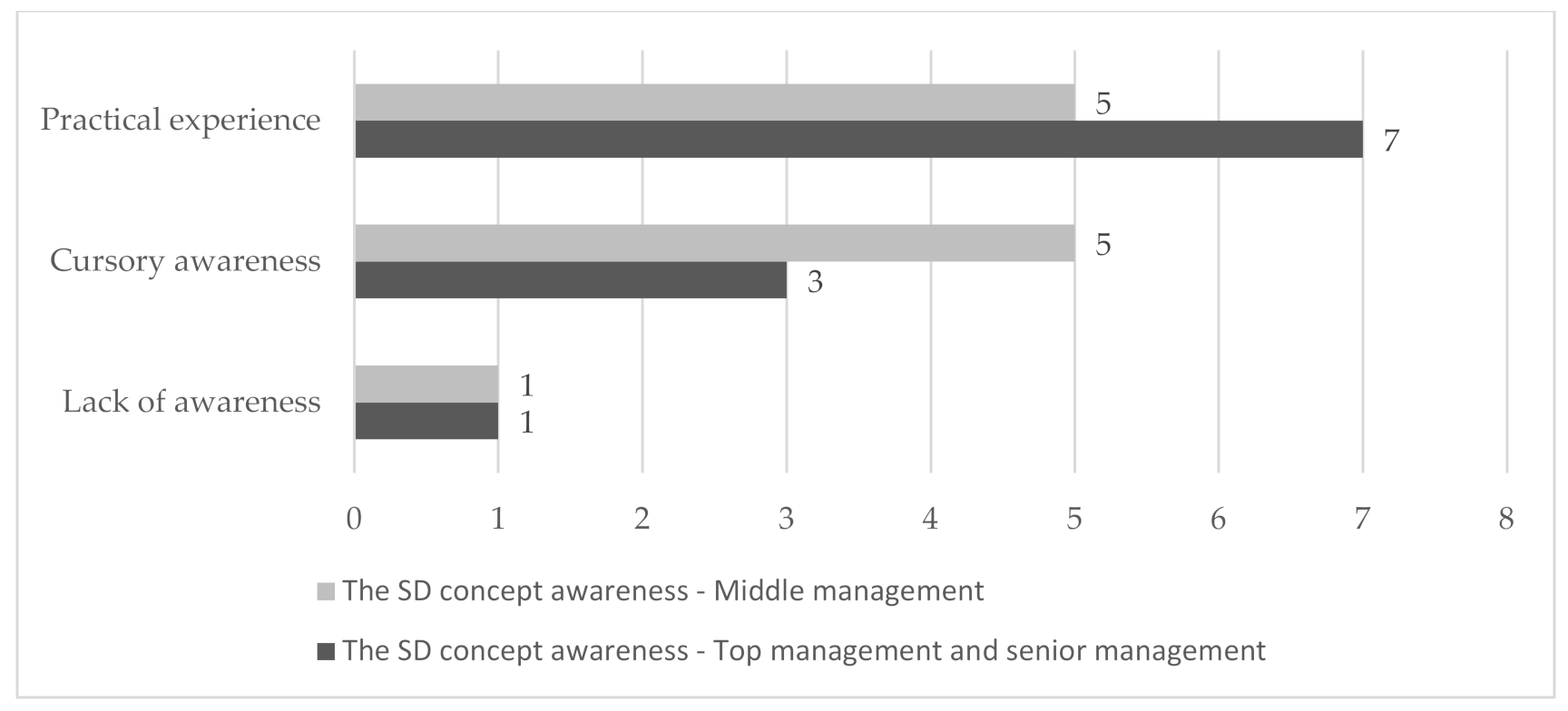
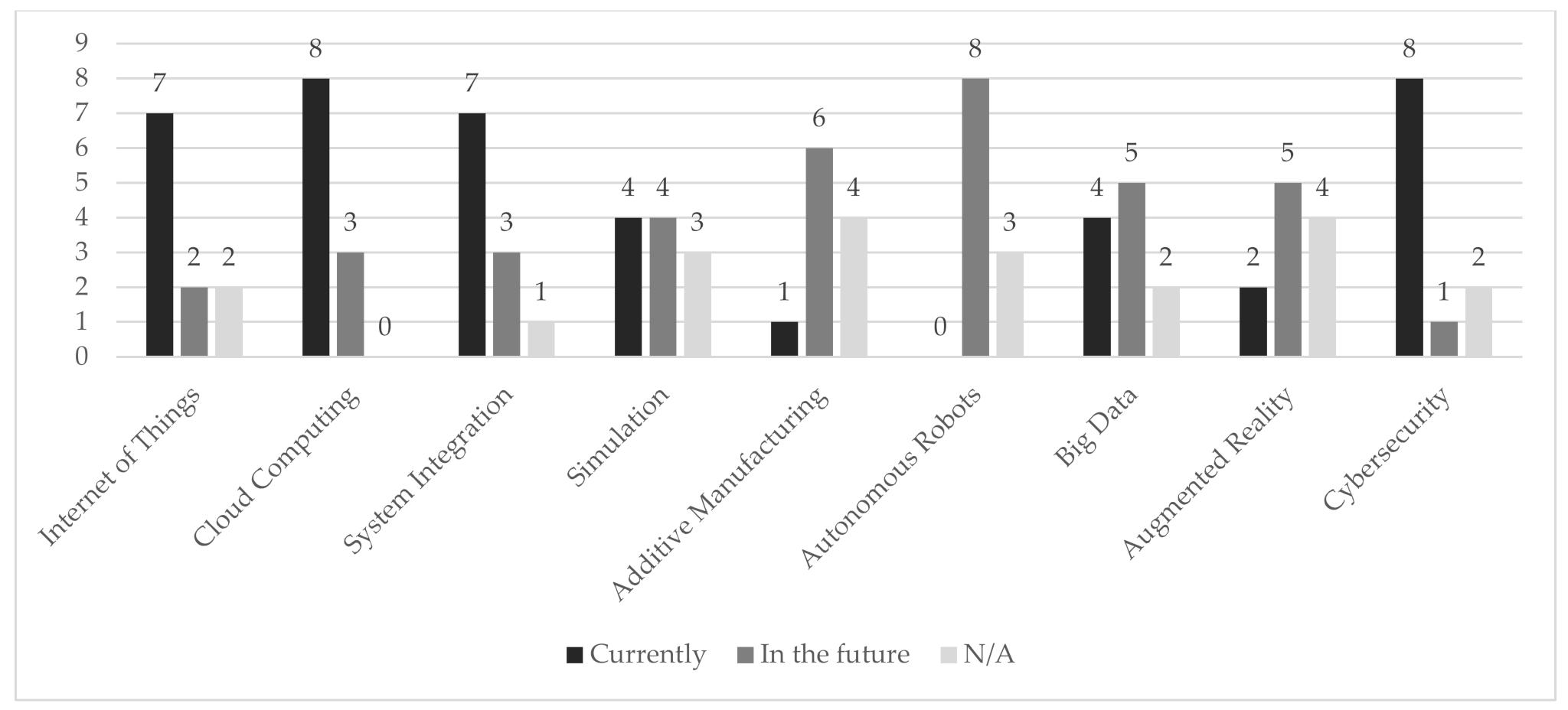

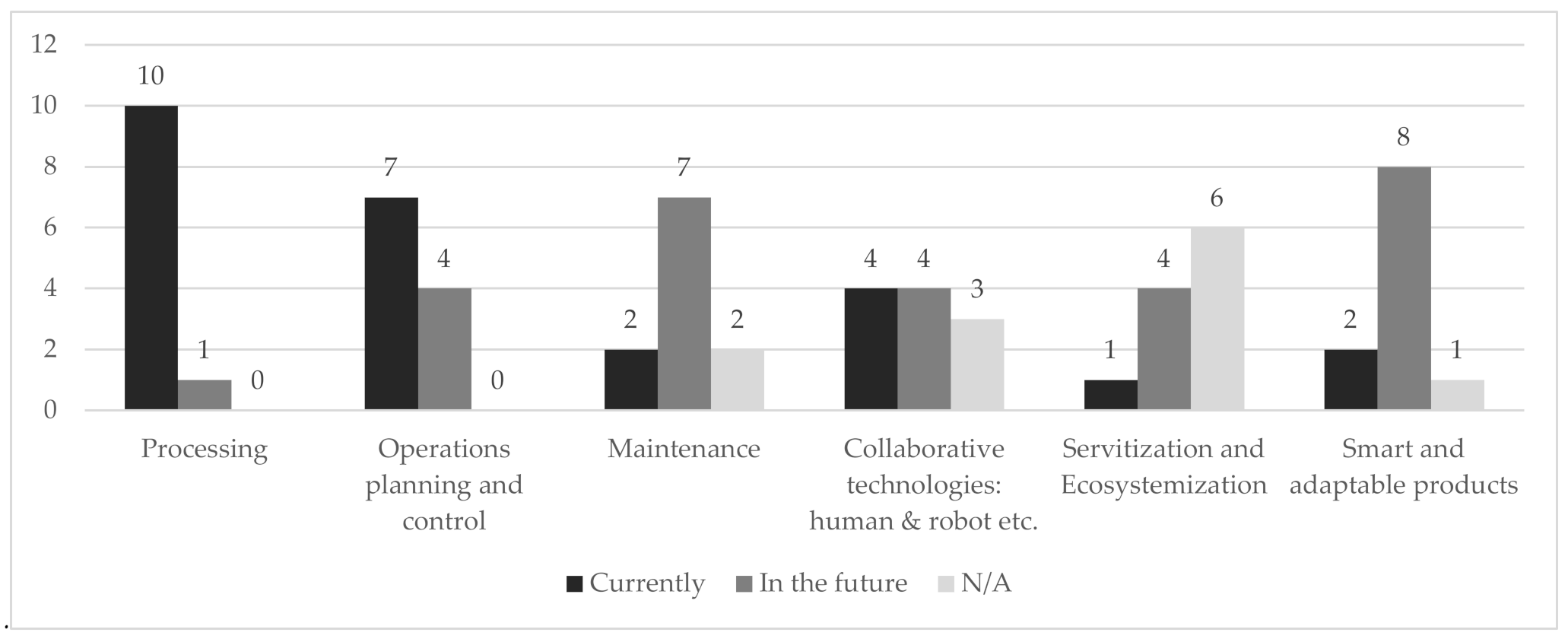


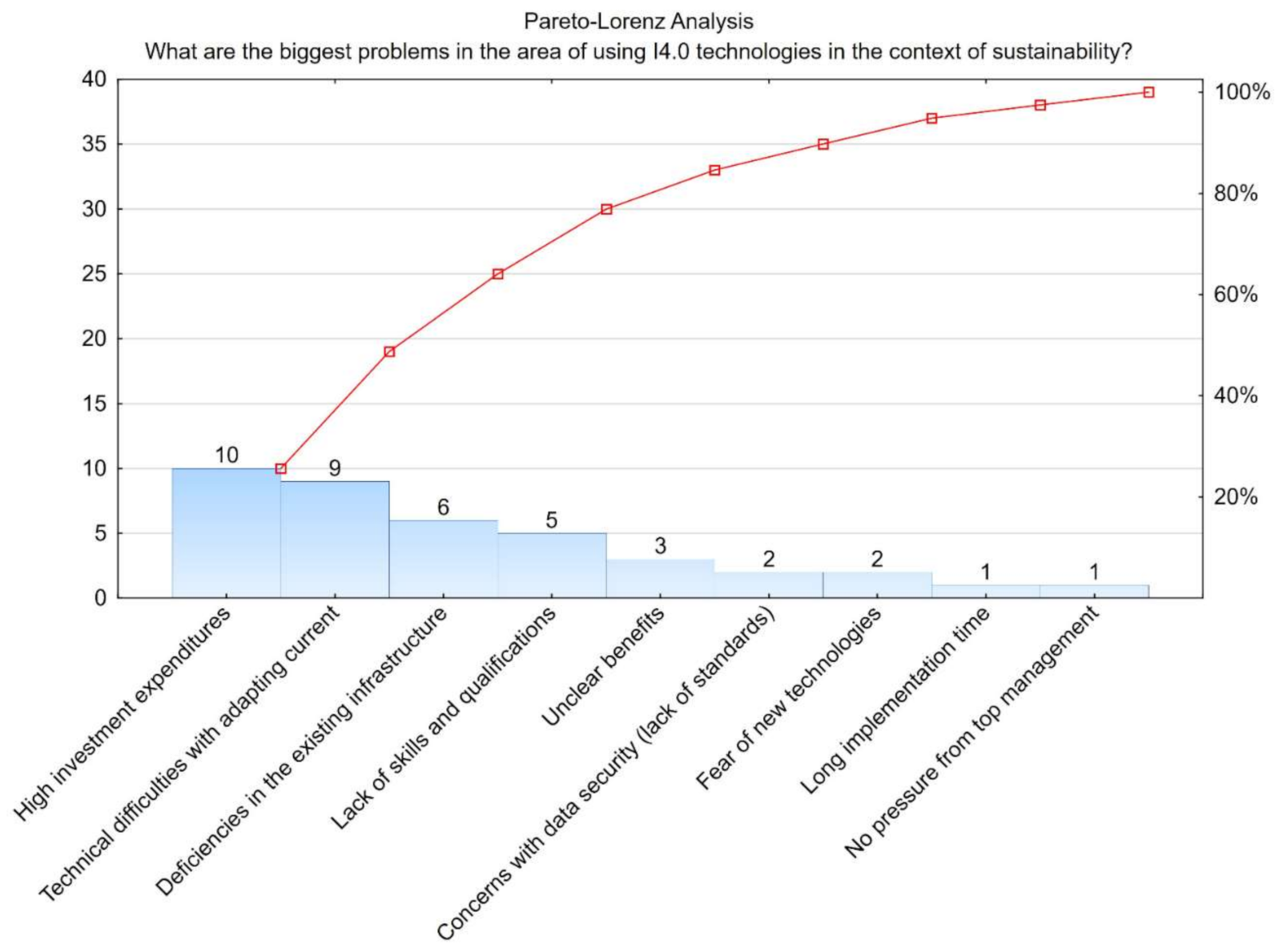

| TBL Perspective | Expected Benefits | Concerns |
|---|---|---|
| Economic | Increased revenues and profitability More accurate planning Shortened lead times Increased reliability of machines | Cost-intensive Possibility of offering new products and services Difficulties with determining full financial benefits and economic efficiency (this can be achieved by using one of I4.0 technologies: computer simulation modelling) |
| Environmental | Increased energy efficiency Decreased manufacturing scrap waste Decreased materials usage Decreased emissions | Increased industrial and post-industrial waste Increased energy consumption Decreased availability of raw materials |
| Social | Increased of safety More ergonomic environment (tasks fitted to persons) | Human–robot interaction (HRI) issues Threat of unemployment Privacy issues |
Publisher’s Note: MDPI stays neutral with regard to jurisdictional claims in published maps and institutional affiliations. |
© 2021 by the authors. Licensee MDPI, Basel, Switzerland. This article is an open access article distributed under the terms and conditions of the Creative Commons Attribution (CC BY) license (https://creativecommons.org/licenses/by/4.0/).
Share and Cite
Gladysz, B.; Krystosiak, K.; Ejsmont, K.; Kluczek, A.; Buczacki, A. Sustainable Printing 4.0—Insights from a Polish Survey. Sustainability 2021, 13, 10916. https://doi.org/10.3390/su131910916
Gladysz B, Krystosiak K, Ejsmont K, Kluczek A, Buczacki A. Sustainable Printing 4.0—Insights from a Polish Survey. Sustainability. 2021; 13(19):10916. https://doi.org/10.3390/su131910916
Chicago/Turabian StyleGladysz, Bartlomiej, Krzysztof Krystosiak, Krzysztof Ejsmont, Aldona Kluczek, and Aleksander Buczacki. 2021. "Sustainable Printing 4.0—Insights from a Polish Survey" Sustainability 13, no. 19: 10916. https://doi.org/10.3390/su131910916
APA StyleGladysz, B., Krystosiak, K., Ejsmont, K., Kluczek, A., & Buczacki, A. (2021). Sustainable Printing 4.0—Insights from a Polish Survey. Sustainability, 13(19), 10916. https://doi.org/10.3390/su131910916







